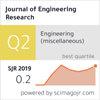住宅建筑节能标准对伊朗实现《巴黎协定》温室气体排放的影响
IF 0.9
4区 工程技术
Q3 ENGINEERING, MULTIDISCIPLINARY
引用次数: 0
摘要
由于全球二氧化碳排放量的增加,各国都被迫采取节能措施,以减轻对环境的负面影响。为了有效地预测未来的状况并评价节能和缓解情景的效力,估计化石燃料的能源消耗和相关的二氧化碳排放量至关重要。伊朗国内部门的能源消耗约占总能源消耗的30%,是本研究的重点。该研究通过考虑气候变化和使用统计数据,开发了一个具有伊朗住宅建筑特征的未来能源消耗和温室气体排放模型。为了评估预期的结果,对“一切照常”和节能方案进行了比较。该研究还评估了几个省份的节能减排潜力。考虑到气候变化对不同气候区域住宅能耗的影响,优先考虑满足《国家建筑法规》中的能源合规性要求。研究结果表明,在不同缓解情景下,2030年和2050年家庭部门二氧化碳排放量预计分别减少15.7%、18.4%、26.8%和31.8%。根据《巴黎协定》,这些减排与伊朗的国家自主贡献目标一致。该研究强调了有针对性的措施和政策实施的重要性,以大幅降低国内部门的二氧化碳排放,支持全球减缓气候变化的努力。这里描述的方法在住宅建筑存量统计数据的限制下解决了与能源相关的挑战。在承认进一步改进的潜力的同时,该国对住宅建筑详细类型的发展有望在未来的研究中提高建模的精度,并对节能策略进行更有力的评估。本文章由计算机程序翻译,如有差异,请以英文原文为准。
The impacts of residential buildings’ energy compliance standards on Iran’s GHG emissions toward achieving the Paris Agreement
Countries have been driven to undertake energy conservation measures to lessen their negative environmental effects due to rising CO2 emissions worldwide. To effectively forecast the future status and evaluate the efficacy of energy-saving and mitigation scenarios, estimating energy consumption and the associated CO2 emissions from fossil fuels is essential. The domestic sector in Iran, liable for using around 30% of the total energy consumption, is the focus of this research. The research has developed a model for future energy consumption and greenhouse gas emissions distinctive to the features of the Iranian residential building stock by considering climate change and using statistical data. To assess prospective results, the Business-As-Usual and energy conservation scenarios are compared. The research also evaluates the potential of energy savings and CO2 reduction across several provinces. The fulfillment of the energy compliance requirements confined in the National Building Regulations by considering the impact of climate change on energy consumption in dwellings of different climate regions has been prioritized. The results show that under different mitigation scenarios, CO2 emissions in the household sector are projected to decrease by 15.7%, 18.4%, 26.8%, and 31.8% by 2030 and 2050. According to the Paris Agreement, these reductions are consistent with Iran's Intended Nationally Determined Contribution. The study emphasizes the significance of targeted measures and policy implementations to lower CO2 emissions in the domestic sector substantially, supporting global efforts to mitigate climate change. The methodology described here addresses energy-related challenges within the constraints of available data on the residential building stock statistic. While acknowledging the potential for further refinement, the country's development of a detailed typology of residential buildings holds promise for enhancing the precision of the modeling in future studies and enabling more robust assessments of energy-saving strategies.
求助全文
通过发布文献求助,成功后即可免费获取论文全文。
去求助
来源期刊

Journal of Engineering Research
ENGINEERING, MULTIDISCIPLINARY-
CiteScore
1.60
自引率
10.00%
发文量
181
审稿时长
20 weeks
期刊介绍:
Journal of Engineering Research (JER) is a international, peer reviewed journal which publishes full length original research papers, reviews, case studies related to all areas of Engineering such as: Civil, Mechanical, Industrial, Electrical, Computer, Chemical, Petroleum, Aerospace, Architectural, Biomedical, Coastal, Environmental, Marine & Ocean, Metallurgical & Materials, software, Surveying, Systems and Manufacturing Engineering. In particular, JER focuses on innovative approaches and methods that contribute to solving the environmental and manufacturing problems, which exist primarily in the Arabian Gulf region and the Middle East countries. Kuwait University used to publish the Journal "Kuwait Journal of Science and Engineering" (ISSN: 1024-8684), which included Science and Engineering articles since 1974. In 2011 the decision was taken to split KJSE into two independent Journals - "Journal of Engineering Research "(JER) and "Kuwait Journal of Science" (KJS).
 求助内容:
求助内容: 应助结果提醒方式:
应助结果提醒方式:


